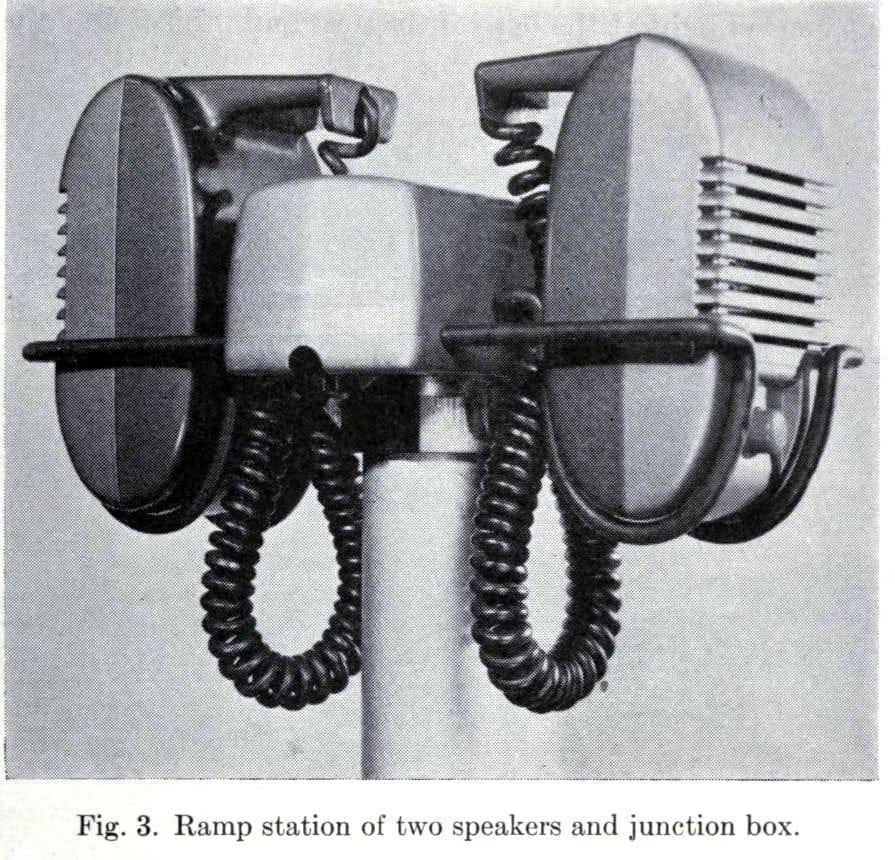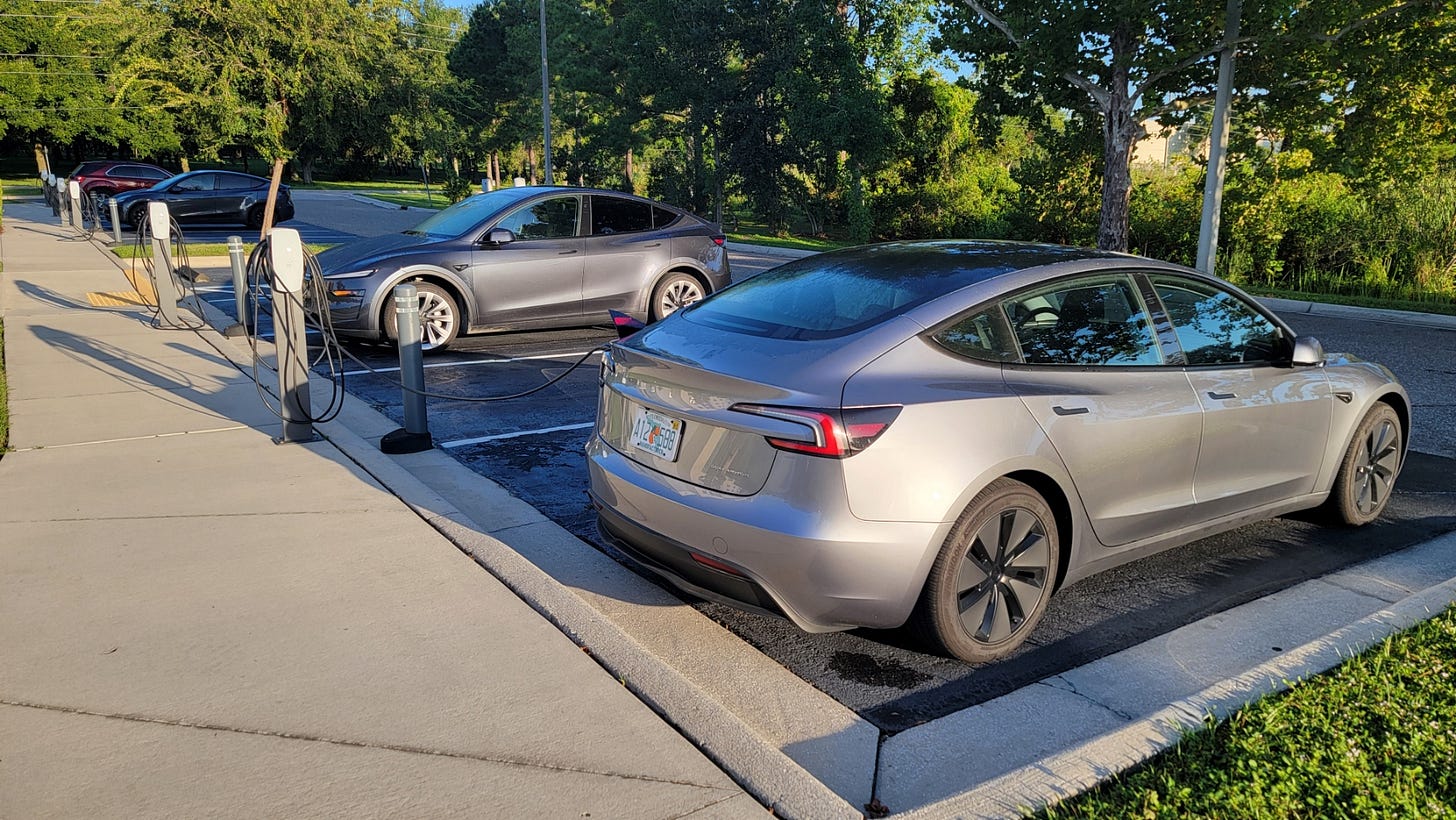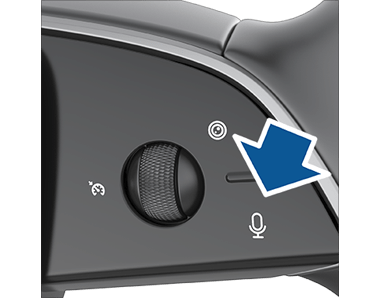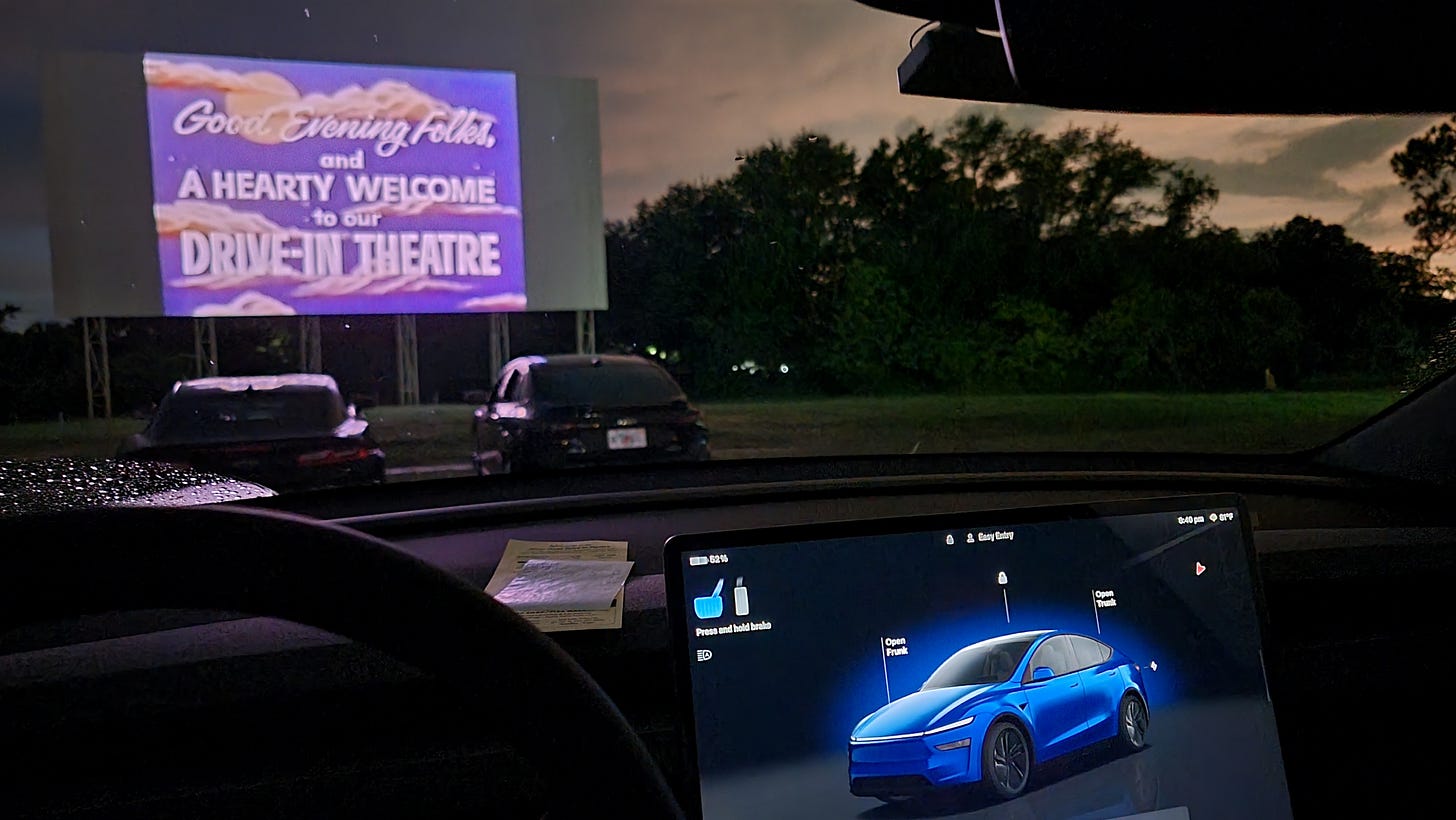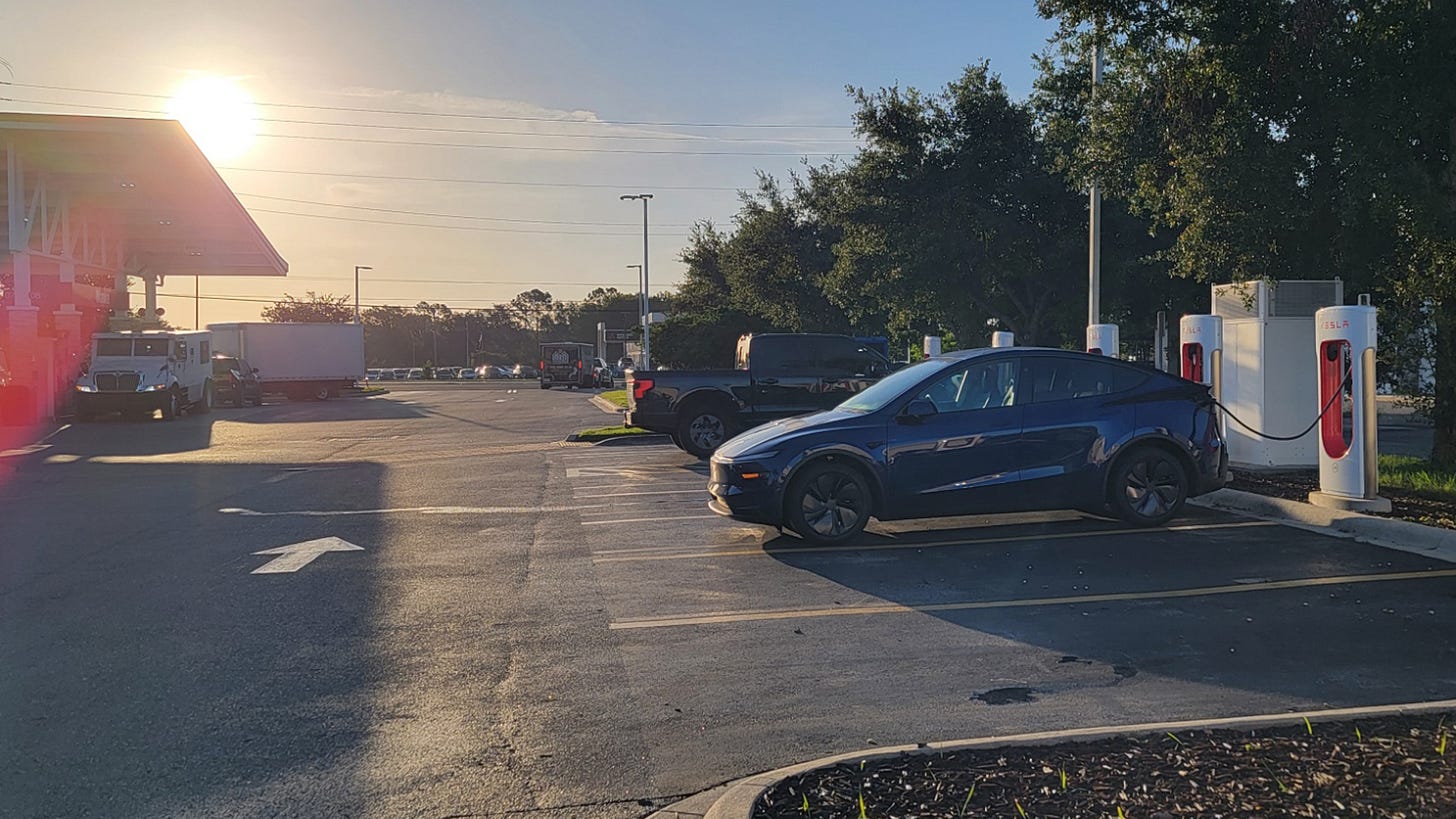There and Back Again
Our first road trip was an overnight outing to Lakeland, Florida to watch a drive-in movie. Here's what we learned.
Drive-in theater speakers from the 1950s. Image source: Click Americana.
Once upon a time, we Baby Boomers were raised by parents who drove the family station wagon to the local drive-in. It was cheap and affordable outdoor entertainment. A projectionist sitting in a room above the concession building shone a film on a giant white screen.
Sound came from speakers attached by cable to a pole. The speaker had a hook to attach to the top of your car door window. Sure, you could see the movie from outside the drive-in fence, but you couldn’t hear the soundtrack.
The experience was imperfect. If the weather was too cold or too hot, you could only run the air conditioning for so long before the car battery wore down. If it rained, well, too bad, no refunds; you could run your windshield wipers, but those too wore down the battery.
Over the decades, drive-ins disappeared. The main reason was that the land was worth more as a commercial complex or housing tract. As theater sound systems improved, that cabled speaker couldn’t match the theatrical experience. Star Wars on a tinny speaker with three or four passengers in a car doesn’t match a theater filled with hundreds being blasted by a THX sound system. Of course, there’s no such thing as a matinée at a drive-in, another reason why drive-ins were no longer economically feasible.
A few drive-ins have survived. The Silver Moon Drive-In Theatre in Lakeland, Florida opened in 1948. According to their website, it’s one of only four drive-ins remaining in Florida.
Like most other existing drive-ins, the aluminum hanging speakers are long gone. These days, you use your car’s FM stereo to listen to the movie audio. The speaker poles are also gone, meaning no more striped parking places. Park where and how you wish.
But the battery problem remains. With our previous expeditions to the Silver Moon driving our internal combustion engine (ICE) vehicle, we could only run the A/C or the windshield wipers for a few minutes without starting the engine to charge the car battery.
We’ve often commented, “If we only had a Tesla, this experience would be quite different.”
The Meter is Running
The drive from Merritt Island to Lakeland is fairly straightforward. When you use the Tesla’s Navigate app, it plots the route for you, but it will also show any congestion along the way.
One important feature is that the app will show you where supercharger stations are. EV chargers come in various designs and charging levels. A Tesla supercharger station is typically a Level 3, or maybe a Level 4. Level 3 devices charge at up to 250kW (kilowatts), which means charging the battery typically takes about a half-hour. You pay to use these; the Navigate app will show the cost, and how many superchargers are available.
The route planner from Lakeland to Merritt Island, with handy directions.
This trip was only 90 miles one way. The “Juniper” Model Y Long-Range Rear Wheel Drive is rated for a range of 357 miles, but that’s unrealistic. We were going to be driving mostly on freeways, in 100°F Florida heat, which meant blasting the air conditioning.
The Model Y owner’s manual recommends charging the battery only up to 80%, but it’s okay to charge above that for road trips. We left Merritt Island with an 87% charge, and arrived at the hotel at 53%.
So figure roughly 30 miles for a 10% charge. The Tesla’s trip counter (you can customize multiple trip counters if you wish) recorded 205.6 miles, total energy 49.7 kWh (kilowatt hours), with average energy of 242.5 Wh/mile.
How much did it cost? Depends on where you charged. Our initial charge was at home, where we pay 11¢ per kilowatt. The Lakeland supercharger near the hotel was 20¢ per kW during off hours (11 PM - 8 AM). Let’s assume I used the supercharger for the entire mileage — 49.7 kWh x .20¢/kw = $9.94.
We spent about ten bucks going 200 miles. Compare to an ICE vehicle that gets 25 miles per gallon. At $3.00/gallon, you would have paid $24. So we saved $14.
Here’s the interesting part. When we arrived at our hotel, the Marriott Towneplace Suites Lakeland, we found it had twelve Level 2 Tesla chargers. A Level 2 charger is much slower than a supercharger, intended for home use. The typical Tesla home charger is a Wall Connector, which Tesla sells for $420.
If you’re not familiar with Elon Musk’s favorite inside joke, he has an obsession with the number 420. How the number 420 became associated with marijuana is in dispute, but in any case Elon sneaks in 420 whenever he can.
In any case, although a supercharger is up to 250 kW, our home Wall Connector is only 11 kW. The hotel’s outdoor chargers were only 10 kW, and cost 30¢ per kilowatt hour. It was cheaper and faster to drive a half-mile up the road to the supercharger.
The big surprise is that Tesla loaned the hotel two cars, a Model 3 and a Model Y, for free demo drives. The hotel desk clerk said that guests may drive one around town for four hours!
The demo-drive Model 3 (foreground) and “Juniper” Model Y parked at the hotel’s Level 2 chargers.
This explains what I saw on Tesla’s supercharging map. If you click on the map icon for the hotel, it lists “Self-Serve Demo Drives without Tesla staff on-site.” You can click a “Schedule a Demo Drive” button to reserve one.
Apparently this program began in January 2024. The Tesla website has a page listing all the places in the United States where you can take a self-serve demo drive.
Oh, that “420” joke? The hotel booked us into Room 420. They did so before knowing we were driving a Tesla. It was strictly a coincidence. I explained Elon’s 420 obsession to the clerk and to the management staff. One manager said, “I paid $420 for my Wall Connector!” I told him why. So now they’re in on the joke.
Our Feature Attraction
The Navigate app directed us to the Silver Moon Drive-In. There are several ways to do that, most of them through the touchscreen, but I prefer using a voice command.
To use a voice command, you press the microphone button on the right side of the steering wheel. Personally, I think this is one of Tesla’s most overlooked and unappreciated features. A lot of what you can do with a Tesla can be controlled through a voice command.
You can speak the address if you have it, but Navigate makes it even simpler. I spoke, “Take me to the Silver Moon Drive-In,” and Navigate plotted the course.
If we had Full Self-Driving, the Model Y would have driven us there, which would have helped because the drive-in is in a remote rural area. Most streets had small street signs, if any. But FSD costs $100 a month, too much for this retiree, so instead I followed the Navigate map instructions and spoken directions.
When we arrived at Silver Moon, a typical Florida lightning storm had settled over the drive-in, so we parked under a carport attached to the concession building.
We were about thirty minutes early, so we bought hot dogs and sodas, and watched YouTube entertainment on the Tesla’s touchscreen until the movie began. You can watch YouTube, Netflix, Hulu, and other streaming services while parked if you have a subscription to the service. If your service isn’t one of those listed, such as Paramount Plus, you can use the browser app to manually access the service.
Welcome to the Silver Moon Drive-In.
The lightning passed, but sprinkles persisted throughout the evening. We found a parking space with the view you see above. From time to time, we manually ran the windshield wipers. The radio app found the FM channel for the movie audio, so that was easy.
We were about a half-hour into the film when the Tesla shut down. No touchscreen. No sound. No power. My first thought was, “Oh crap, we bricked!” To “brick” a Tesla means it’s dead as a doorstop, so you might as well use it as one. The term “brick” goes back at least to 2012. The Tesla interior has emergency door releases so you can exit, but I tried the electric door button first. It worked. Whew, we’re not bricked.
(ICE cars brick all the time. We’ve all had dead batteries. Pot, kettle, black.)
I later found this passage in the owner manual:
Model Y also powers off automatically after being in Park for 30 minutes, even if you are sitting in the driver’s seat.
Lesson learned.
How to circumvent it?
You can open and close the door like I did, but there’s a simpler solution. It’s called Camp Mode, under the Climate settings.
Camp allows you to power electronics through the USB ports and low voltage outlet in addition to maintaining the cabin temperature. The touchscreen remains on so you can play music, browse the internet, play games in the arcade, or watch shows in Tesla Theater. You can also control media and climate settings from a paired phone. Camp is ideal for remaining inside your vehicle, such as camping or staying with a child.
Since the purpose of the trip was to learn what we don’t know about new experiences in the Tesla, this was a painless yet valuable lesson.
To return to the hotel, I used the voice command. “Take us to the Townplace Suites Lakeland.” It plotted a course. Engage.
The Morning After
Before we drove back to Merritt Island, I wanted to recharge the Model Y. We had about 50% left on the battery even after sitting at the drive-in for two hours, and probably could have made it home, but again this trip was our test flight.
These days, many supercharger stations are near restaurants and coffee shops. This one was in a Wawa parking lot next to a First Watch restaurant. It took about a half-hour to charge to 85%. Many EV travellers let the car charge while they eat or use the restroom. But don’t leave your car after it’s charged, because some superchargers will bill you extra for occupying a spot someone else could use.
Sunrise at the supercharger. That’s a Ford F-150 Lightning charging behind our Model Y. Ford and other non-NACS compliant EVs need an adapter to use a Tesla supercharger.
Because our Tesla app is directly linked to a charge card on file, I didn’t have to swipe or tap a card. There’s no place to do that. The app automatically detects the charger and bills your card.
The drive home was as projected. The Tesla will project the amount of miles you’ll travel and how much power you’ll have left when you arrive. It was spot-on — 50%.
We agree the trip was a fantastic experience. It was all we imagined when we used to make the pilgrimage in our ICE vehicle. We learned new tricks, which we’re passing on to you.
Go find a drive-in and travel back to the future.


